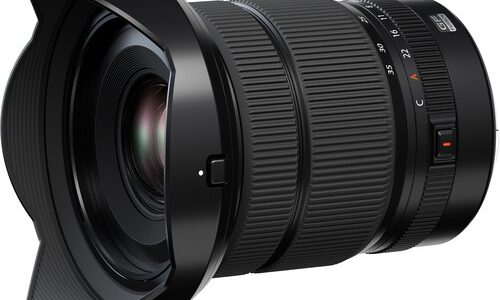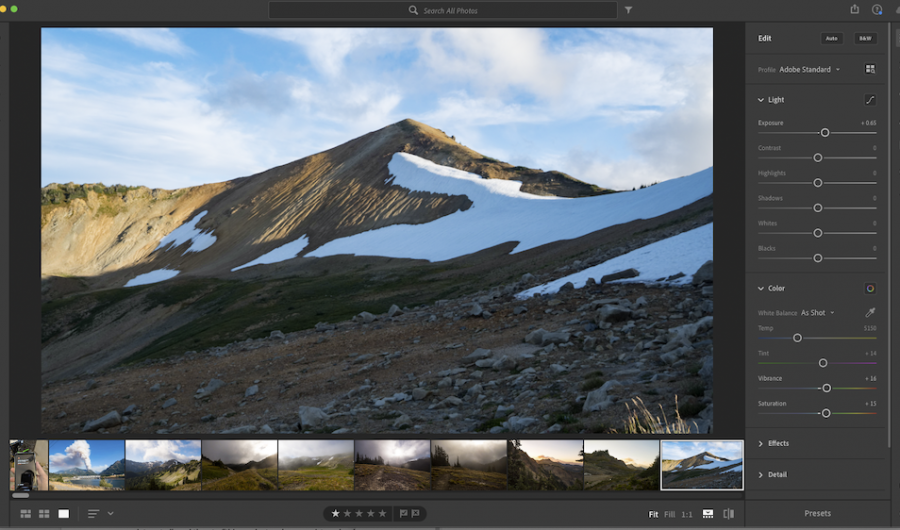

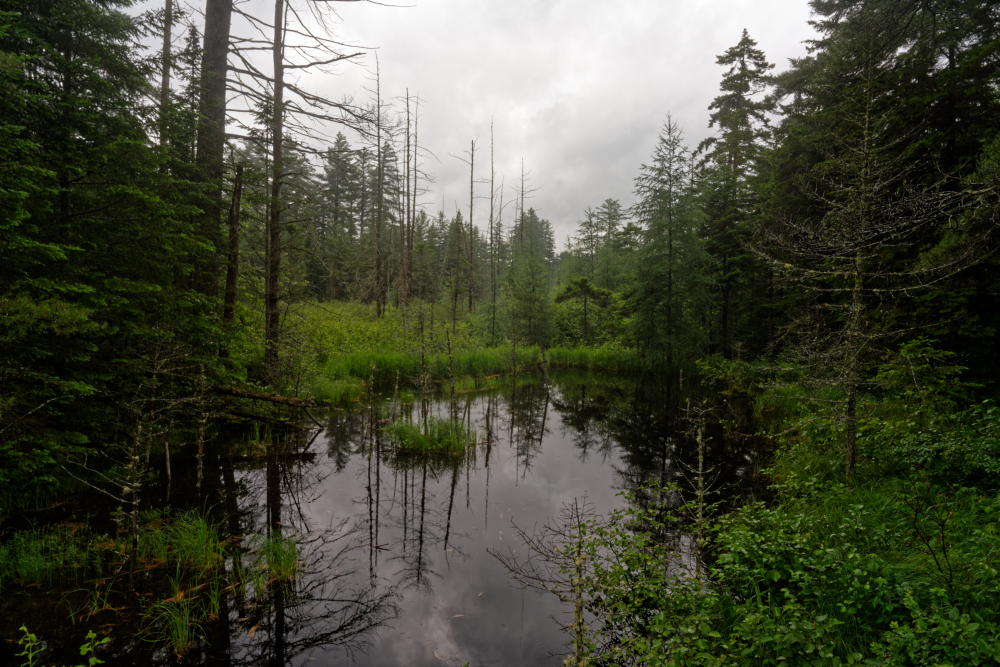
The future of Lightroom looks distinctly cloudy
This week is Adobe’s annual Adobe MAX conference, where they set the direction of their products for the upcoming year – and there’s not much for photographers here, especially for subscription software where we’re paying for the updates whether we want them or not. As disturbing as the lack of updates is that what did get updated shows their direction – it’s not mine, and it may not be yours either.
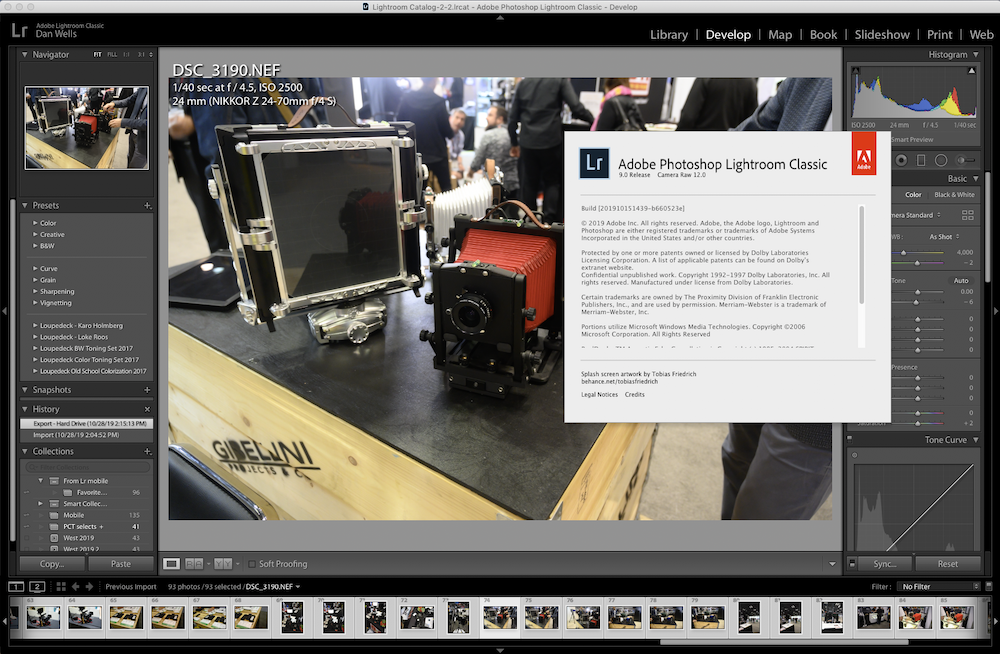
Today’s version of Lightroom Classic – the tiny text right under the words Adobe Photoshop Lightroom Classic says “9.0 Release”, and it’s about the only way to tell anything’s changed.
Here are the updates to Lightroom Classic – the desktop software that most of us call Lightroom. These are the updates as listed in Adobe’s own blog, although the descriptions are mine. Adobe MAX is often the biggest update of the year, and where next year’s version appears (as much as that concept still applies).
Panorama Fill Edges (adds artificial content to the edges of a panorama instead of needing to crop out the white space)
Multi-Batch Export (Capture One has had this since Version 7 or earlier, and DxO and others do too. It’s about time, but not a big update).
Export Presets (not presets for exporting, but an improvement to the ability to export Develop presets from machine to machine). Possibly useful, but pretty trivial except in the case of a studio with a whole fleet of machines.
That’s all, folks! This is usually the direction-setting update to Lightroom for the year, and it was accompanied by a new version number – Lightroom Classic as of November 4, 2019 is officially “Lightroom 9.0”. We got an improvement to the panorama feature, a long-overdue export feature and a minor piece for syncing presets. No update to the raw conversion engine, which is now significantly behind several other products. No high-end local adjustments like DxO is doing. No change to how Lightroom Classic uses GPUs.
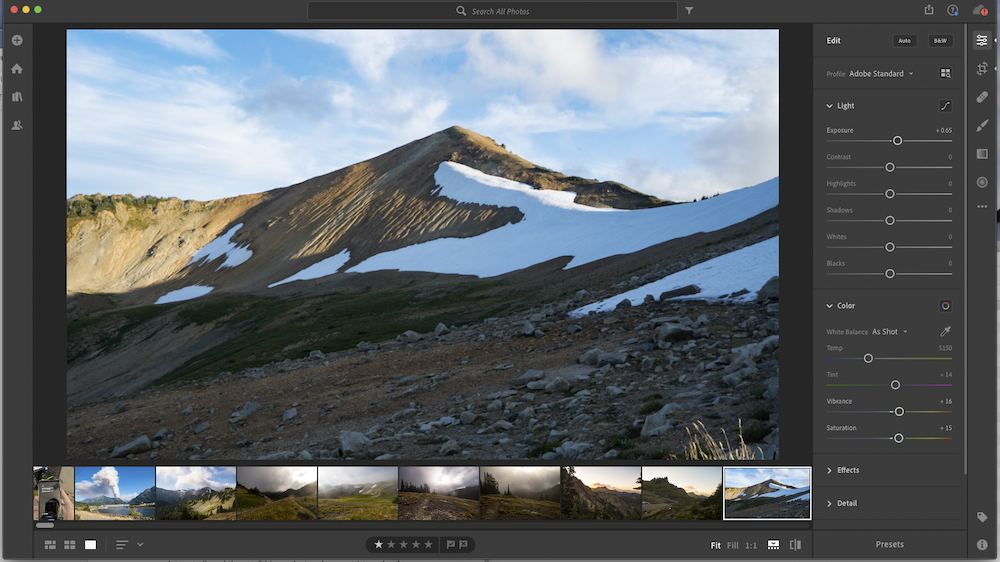
Welcome to the new face of Lightroom – this is Lightroom CC (the cloud-centric version) running on my MacBook Pro – if you think it looks like an iPad, you’re not alone
The real improvements to Lightroom came to the cloud-centric Lightroom product (which Adobe now just calls Lightroom). That got the GPU acceleration we’ve been waiting for on the desktop product, although it’s not immediately clear how many functions got accelerated. Cloud-centric Lightroom also got major updates to export functionality, and its first ever print functionality – it now sends images directly to Adobe partner lab White House Custom Color, although it still ignores the printer sitting next to your desk.
It’s pretty clear that, like it or not, cloud-centric Lightroom (which exists for both desktop and mobile OS types) is the Lightroom that will get the love going forward. Adobe wants to move your images to their cloud, and to charge you $10/TB/month for the privilege. Desktop Lightroom has settled into a maintenance state, and it has settled while it is significantly behind other software in important ways.
Here are the updates to Photoshop (again, straight from Adobe):
Improvements to Presets
New Object Selection Tool
Improved Properties Panel
Consistent Transform Behavior (mostly improved defaults)
Enhanced Content-Aware Fill (some minor changes to where it gets its data from).
Again, relatively minor updates. The object selection tool is probably the big one for photographers, and it is nowhere near where some of its competitors’ smart masking and feathering are. DxO is presently in the lead here, with their incredibly powerful masking tools.
Here’s what Adobe focused on instead – taken from the titles of their main MAX blog post:
Photoshop on iPad
Adobe Fresco (iPad painting app)
Illustrator on iPad
Creative Cloud Desktop and Libraries (this is not the desktop programs themselves, but the program that organizes them, which is called “Creative Cloud Desktop”).
Photoshop Camera (phone camera)
Adobe XD coediting (XD is a mobile app interface design tool)
Adobe Aero (AR design)
Adobe Substance (3D)
There are some improvements to Premiere and other video editing tools, and some to InDesign and the rest of the graphic design suite – but, overall, it’s a pretty disappointing set of updates for people interested in photography and even video. The overwhelming theme is phones, tablets, AR and cloud services.
Is it worth paying the subscription cost to Adobe for what you do? Adobe seems to be trying to phase out the cloud-light Photography Plan, which offers desktop Lightroom and Photoshop with only 20 GB of cloud storage for $10/month – it’s still available, but they’ve been hiding it on their website at different times. They are working towards the new baseline being cloud-centric Lightroom (only) with 1 TB of storage for $10/month, or including desktop Lightroom Classic and Photoshop along with the cloud package, but charging$20/month. $20/month is a lot to pay, especially for software that is primarily getting maintenance releases. If the $10/month option goes away, Adobe will have the most expensive raw converter/editor on the market – with close to the lowest image quality. Yes, it will come with a lot of phone and cloud extras – but not all of us want phone and cloud extras.
Adobe’s workflow is unbeatable – nobody else can take you from import to print in one application. Transitioning to DxO PhotoLab, Capture One, On1 or Luminar will probably mean using a separate print application, and perhaps a separate Digital Asset Manager (DAM) as well, depending on how sophisticated your needs are in image search.
On the other hand, all four competing products offer significant image quality improvements over Lightroom.
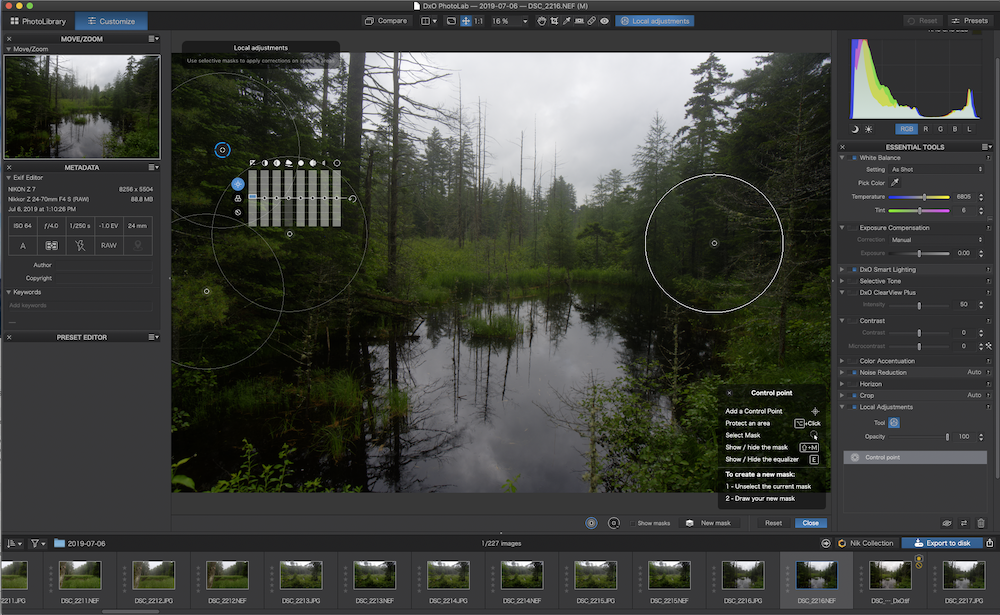
DxO is really pushing the limits with their local editing functionality, and they have just introduced a very powerful selective color capability in PhotoLab 3. Their UPoint local editing technology creates complex masks in minutes that would take many hours in the darkroom (or in Lightroom). Their noise reduction is second to none and their new clarity features are well beyond what Lightroom offers. DxO came out of a lens correction background, and their distortion corrections are far more sophisticated than anyone else’s. It is amazing to see what DxO can do with something like a Nikkor Z 14-30mm f4.
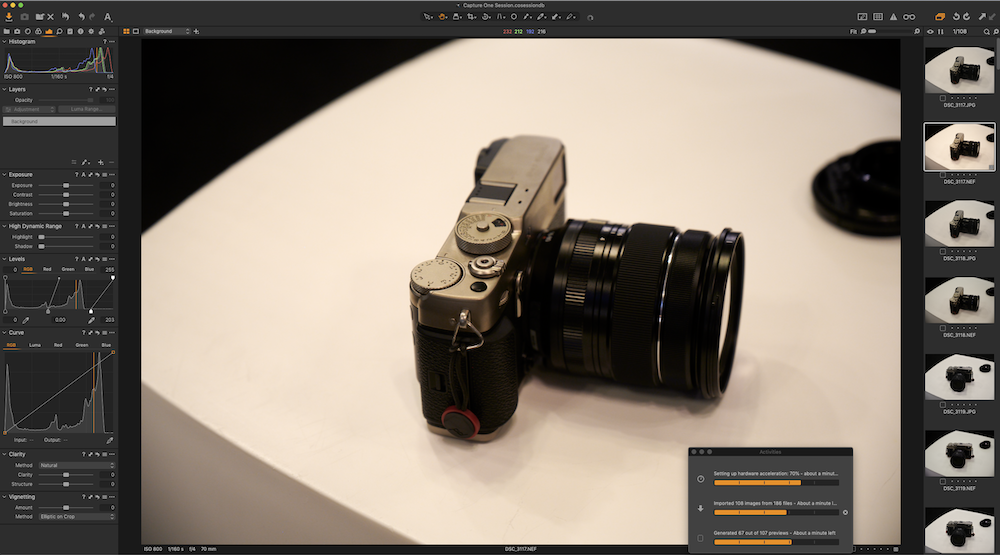
Capture One excels in the studio, with tethering functionality that exceeds any other product’s. Their camera profiles are generally spot-on, and quite a bit better than anything Adobe offers. For most cameras, most of the time, the best default rendering will be in Capture One (or perhaps some other non-Adobe option). Their color editing is a great deal more powerful than Adobe’s – the only real competitor is DxO’s brand new functionality in Version 3. Nothing exports like Capture One – it’ll export many versions of a file for different uses at the click of a button.
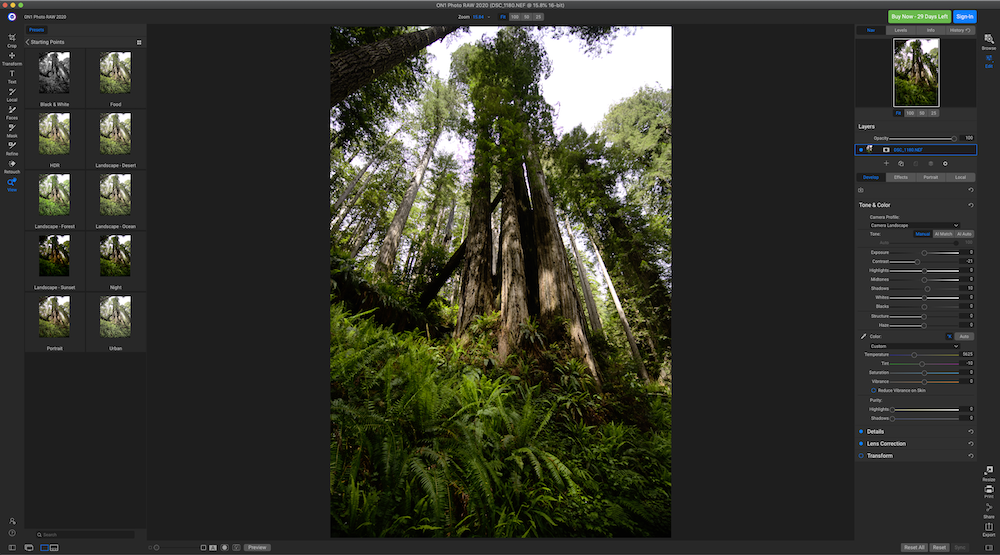
On1 showing some (of many) preset possibilities and sliders for further adjustments.
On1 and Luminar offer a completely different, more preset-based editing experience. Both offer a substantial collection of sliders, covering the basics of image adjustment, although without some of the power of DxO, Capture One or even Lightroom. Much of their power is in presets that apply an overall look to an image, using AI to get there. You can choose from hundreds of presets, then use the sliders to fine-tune from an AI-derived base. If you aren’t going to choose a preset, one of the editors that offers full control over image parameters will be much more powerful – but the presets offer a place to start. The individual image adjustments are more at the level of Photoshop Elements than Capture One, because they assume you’ll use a preset to get close to what you want.
Each editor has their own strengths – DxO has exceptional noise reduction and sharpening (NiK Sharpener is part of the package), while On1’s resizing is Genuine Fractals, one of the best resizing tools on the market. Capture One’s tethering tools alone are probably worth the price of entry for a busy studio.
None of them offers the DAM capability of Lightroom, although they are generally improving in that regard – and none of them offers printing capability at the level of Lightroom’s Print module. It is these extras that make Lightroom a viable product in today’s market, even with its class-trailing image quality. Various competitors offer different levels of “migrate my work from Lightroom”, but none of them is perfect. Switching to any alternative will involve a substantial effort, both in migrating your images and in learning a new and complex piece of software.
On the other hand, it’s clear that Adobe wants photographers to switch, too – to their cloud-centric, mobile-centric products. How many more years of Lightroom Classic are left, and how quickly will Adobe shut it down when they decide to? Since Lightroom Classic is subscription only software, Adobe can discontinue it at any point. The maintenance updates could change to no updates at all, and then to “this product no longer exists – cloud-centric Lightroom is the only Lightroom”. Especially for photographers with large libraries or slow internet connections, switching from Lightroom Classic to cloud-centric Lightroom could actually be more disruptive than switching from Lightroom Classic to DxO, Capture One, On1 or Luminar. It could also be more expensive – photographers with multi-terabyte image libraries need to look at the cost of storing those libraries on Adobe’s cloud if that goes from a heavily promoted feature to the only way to access Lightroom.
Over the next few months, I will be looking at the alternatives to Lightroom and at other software that will be part of a post-Adobe workflow – notably printing software including both the highly affordable QImage and the incredibly flexible ImagePrint. Interviews with Jéróme Abribat from DxO, John Pannozzo from ImagePrint developer ColorByte Software and others in the industry will shed light on the world beyond image capture when Adobe is no longer the only game in town.
Whether each of us chooses to stay or switch, it is important to be aware of the direction Adobe’s software is taking, and that photographers storing large images on their home, office or studio systems are no longer their market for Creative Cloud. There are advantages to Lightroom Classic, primarily in the area of integrated workflow, that will make it worthwhile for some photographers to stay for as long as they can. My best guess is that we see one more minor “update” to Lightroom Classic, and version 10 will come out at Adobe MAX 2020 (with changes as trivial as today’s), then the announcement that Lightroom Classic is done might come at Adobe MAX 2021. They’ll give 6 months or a year after the announcement before shutting Lightroom Classic down, , to give us time to upload our files to the cloud (or move to a competitor). At the latest, “no more Lightroom” day might be at the end of 2022? On the other hand, an announcement that Lightroom Classic is done as early as Adobe MAX 2020 is possible, and if they only give a 6 month grace period, it is possible that Lightroom Classic ceases to function as early as the middle of 2021.
Cloud-centric Lightroom will undoubtedly get better, and it is a product to watch. On the other hand, unless you’re fully comfortable with getting switched to Lightroom in the cloud, all photographers should be aware of the alternatives.
Dan Wells
November 2019

Lorem ipsum dolor sit amet, consectetur adipiscing elit, sed do eiusmod tempor incididunt ut labore et dolore magna aliqua. Ut enim ad minim veniam, quis nostrud exercitation ullamco laboris nisi ut aliquip ex ea commodo consequat. Duis aute irure dolor in reprehenderit in voluptate velit esse cillum dolore eu fugiat nulla pariatur. Excepteur sint occaecat cupidatat non proident, sunt in culpa qui officia deserunt mollit anim id est laborum.
Lorem ipsum dolor sit amet, consectetur adipiscing elit, sed do eiusmod tempor incididunt ut labore et dolore magna aliqua. Ut enim ad minim veniam, quis nostrud exercitation ullamco laboris nisi ut aliquip ex ea commodo consequat. Duis aute irure dolor in reprehenderit in voluptate velit esse cillum dolore eu fugiat nulla pariatur. Excepteur sint occaecat cupidatat non proident, sunt in culpa qui officia deserunt mollit anim id est laborum.
Lorem ipsum dolor sit amet, consectetur adipiscing elit, sed do eiusmod tempor incididunt ut labore et dolore magna aliqua. Ut enim ad minim veniam, quis nostrud exercitation ullamco laboris nisi ut aliquip ex ea commodo consequat. Duis aute irure dolor in reprehenderit in voluptate velit esse cillum dolore eu fugiat nulla pariatur. Excepteur sint occaecat cupidatat non proident, sunt in culpa qui officia deserunt mollit anim id est laborum.

Lorem ipsum dolor sit amet, consectetur adipiscing elit, sed do eiusmod tempor incididunt ut labore et dolore magna aliqua. Ut enim ad minim veniam, quis nostrud exercitation ullamco laboris nisi ut aliquip ex ea commodo consequat. Duis aute irure dolor in reprehenderit in voluptate velit esse cillum dolore eu fugiat nulla pariatur. Excepteur sint occaecat cupidatat non proident, sunt in culpa qui officia deserunt mollit anim id est laborum.

Lorem ipsum dolor sit amet, consectetur adipiscing elit, sed do eiusmod tempor incididunt ut labore et dolore magna aliqua. Ut enim ad minim veniam, quis nostrud exercitation ullamco laboris nisi ut aliquip ex ea commodo consequat. Duis aute irure dolor in reprehenderit in voluptate velit esse cillum dolore eu fugiat nulla pariatur. Excepteur sint occaecat cupidatat non proident, sunt in culpa qui officia deserunt mollit anim id est laborum.
Lorem ipsum dolor sit amet, consectetur adipiscing elit, sed do eiusmod tempor incididunt ut labore et dolore magna aliqua. Ut enim ad minim veniam, quis nostrud exercitation ullamco laboris nisi ut aliquip ex ea commodo consequat. Duis aute irure dolor in reprehenderit in voluptate velit esse cillum dolore eu fugiat nulla pariatur. Excepteur sint occaecat cupidatat non proident, sunt in culpa qui officia deserunt mollit anim id est laborum.
Lorem ipsum dolor sit amet, consectetur adipiscing elit, sed do eiusmod tempor incididunt ut labore et dolore magna aliqua. Ut enim ad minim veniam, quis nostrud exercitation ullamco laboris nisi ut aliquip ex ea commodo consequat. Duis aute irure dolor in reprehenderit in voluptate velit esse cillum dolore eu fugiat nulla pariatur. Excepteur sint occaecat cupidatat non proident, sunt in culpa qui officia deserunt mollit anim id est laborum.

Lorem ipsum dolor sit amet, consectetur adipiscing elit, sed do eiusmod tempor incididunt ut labore et dolore magna aliqua. Ut enim ad minim veniam, quis nostrud exercitation ullamco laboris nisi ut aliquip ex ea commodo consequat. Duis aute irure dolor in reprehenderit in voluptate velit esse cillum dolore eu fugiat nulla pariatur. Excepteur sint occaecat cupidatat non proident, sunt in culpa qui officia deserunt mollit anim id est laborum.
Lorem ipsum dolor sit amet, consectetur adipiscing elit, sed do eiusmod tempor incididunt ut labore et dolore magna aliqua. Ut enim ad minim veniam, quis nostrud exercitation ullamco laboris nisi ut aliquip ex ea commodo consequat. Duis aute irure dolor in reprehenderit in voluptate velit esse cillum dolore eu fugiat nulla pariatur. Excepteur sint occaecat cupidatat non proident, sunt in culpa qui officia deserunt mollit anim id est laborum.
Lorem ipsum dolor sit amet, consectetur adipiscing elit, sed do eiusmod tempor incididunt ut labore et dolore magna aliqua. Ut enim ad minim veniam, quis nostrud exercitation ullamco laboris nisi ut aliquip ex ea commodo consequat. Duis aute irure dolor in reprehenderit in voluptate velit esse cillum dolore eu fugiat nulla pariatur. Excepteur sint occaecat cupidatat non proident, sunt in culpa qui officia deserunt mollit anim id est laborum.

Lorem ipsum dolor sit amet, consectetur adipiscing elit, sed do eiusmod tempor incididunt ut labore et dolore magna aliqua. Ut enim ad minim veniam, quis nostrud exercitation ullamco laboris nisi ut aliquip ex ea commodo consequat. Duis aute irure dolor in reprehenderit in voluptate velit esse cillum dolore eu fugiat nulla pariatur. Excepteur sint occaecat cupidatat non proident, sunt in culpa qui officia deserunt mollit anim id est laborum.

Lorem ipsum dolor sit amet, consectetur adipiscing elit, sed do eiusmod tempor incididunt ut labore et dolore magna aliqua. Ut enim ad minim veniam, quis nostrud exercitation ullamco laboris nisi ut aliquip ex ea commodo consequat. Duis aute irure dolor in reprehenderit in voluptate velit esse cillum dolore eu fugiat nulla pariatur. Excepteur sint occaecat cupidatat non proident, sunt in culpa qui officia deserunt mollit anim id est laborum.
Lorem ipsum dolor sit amet, consectetur adipiscing elit, sed do eiusmod tempor incididunt ut labore et dolore magna aliqua. Ut enim ad minim veniam, quis nostrud exercitation ullamco laboris nisi ut aliquip ex ea commodo consequat. Duis aute irure dolor in reprehenderit in voluptate velit esse cillum dolore eu fugiat nulla pariatur. Excepteur sint occaecat cupidatat non proident, sunt in culpa qui officia deserunt mollit anim id est laborum.
Lorem ipsum dolor sit amet, consectetur adipiscing elit, sed do eiusmod tempor incididunt ut labore et dolore magna aliqua. Ut enim ad minim veniam, quis nostrud exercitation ullamco laboris nisi ut aliquip ex ea commodo consequat. Duis aute irure dolor in reprehenderit in voluptate velit esse cillum dolore eu fugiat nulla pariatur. Excepteur sint occaecat cupidatat non proident, sunt in culpa qui officia deserunt mollit anim id est laborum.
You May Also Enjoy...
Hand’s On: new Sony A9III and Sony 50mm G Master, Sony 85mm G Master, Sony 75-350mm APS lenses
A quick hands on look at Sony A9iii and the Sony APS 75-350mm len
The best wide-angle zoom in the world? The Fujinon G5 20-35mm f4 R WR reviewed.
FUJIFILM GF 20-35mm f/4 R WR L

